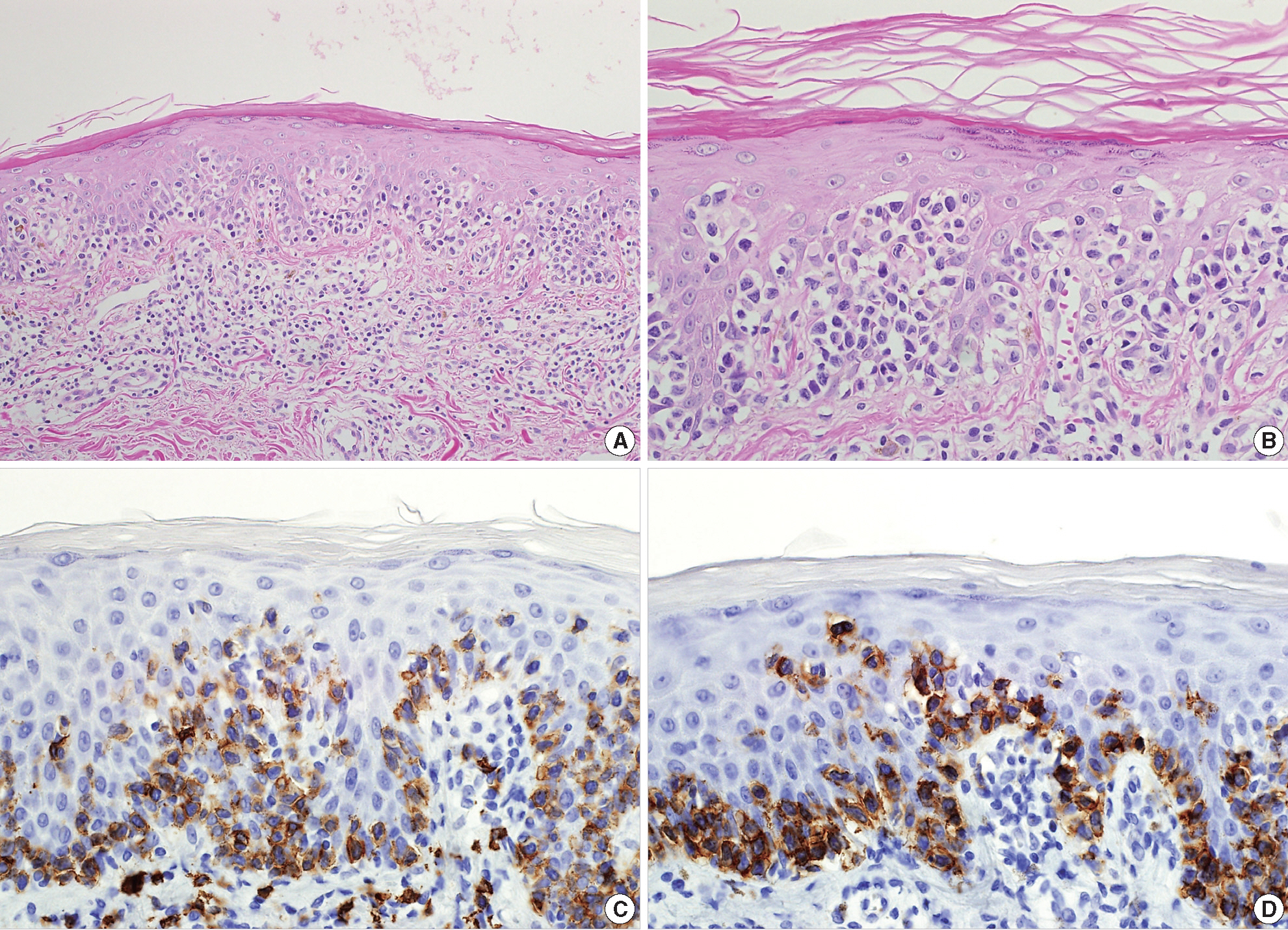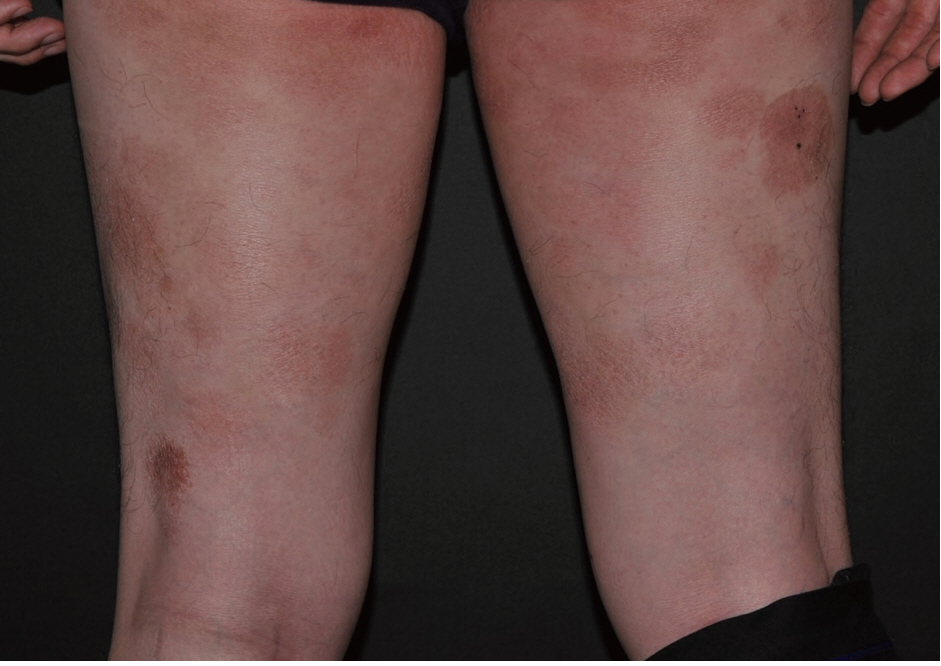Articles
- Page Path
- HOME > J Pathol Transl Med > Volume 48(5); 2014 > Article
-
Brief Case Report
Cytotoxic Variant of Mycosis Fungoides with CD8+ CD56+ Phenotype: A Case Report and Review of Literature - Meeran Kim, Moon Il Park, Myung Lim1, Jinman Kim
-
Korean Journal of Pathology 2014;48(5):390-393.
DOI: https://doi.org/10.4132/KoreanJPathol.2014.48.5.390
Published online: October 27, 2014
Departments of Pathology, Chungnam National University Hospital, Daejeon, Korea
1Departments of Dermatology, Chungnam National University Hospital, Daejeon, Korea
- Corresponding Author: Jinman Kim, M.D. Department of Pathology, Regional Cancer Center, and Infection Signaling Network Research Center, Chungnam National University School of Medicine, 266 Munhwa-ro,Jung-gu, Daejeon 301-747, Korea Tel: +82-42-580-8237, Fax: +82-42-581-5233, E-mail: jinmank@cnu.ac.kr
• Received: September 9, 2013 • Accepted: October 15, 2013
© 2014 The Korean Society of Pathologists/The Korean Society for Cytopathology
This is an Open Access article distributed under the terms of the Creative Commons Attribution Non-Commercial License (http://creativecommons.org/licenses/by-nc/3.0/) which permits unrestricted noncommercial use, distribution, and reproduction in any medium, provided the original work is properly cited.
Figure & Data
References
Citations
Citations to this article as recorded by 

- Chronic Radiation Dermatitis Secondary to Narrow-Band Ultraviolet B Therapy in a Patient With Primary Cutaneous CD8+ T-Cell Lymphoma With Cytotoxic Granules
Mia P. Edelson, Jane J. Gay, Robert W. Thiel, Douglas J. Grider
The American Journal of Dermatopathology.2024; 46(5): 312. CrossRef - Null T‐cell phenotype mycosis fungoides with aberrant CD20 and CD56 expression: A diagnostic dilemma
Brenna M. Aran, Regina Burton, Whitney A. High, Alejandro A. Gru
Journal of Cutaneous Pathology.2024; 51(8): 614. CrossRef - Primary cutaneous CD8+ cytotoxic T‐cell lymphoma of the face with intraoral involvement, resulting in facial nerve palsy after chemotherapy
Daphine Caxias Travassos, Heitor Albergoni Silveira, Evânio Vilela Silva, Beatriz Zamboni Martins Panucci, Nilson Coelho da Silva Filho, Paula Verona Ragusa Silva, Andreia Bufalino, Jorge Esquiche León
Journal of Cutaneous Pathology.2022; 49(6): 560. CrossRef - A Study of Antimicrobial Activity of Herbal Extracts on Clostridium difficile
Eunhak Seong, Sookyoung Lim, Myeongjong Lee, Hojun Kim
Journal of Korean Medicine Rehabilitation.2021; 31(1): 47. CrossRef - Rare case of CD8+ CD56+ cytotoxic variant of mycosis fungoides clinically presenting with a combination of hypopigmentation and poikiloderma
Min‐Young Park, Shinwon Hwang, Jemin Kim, Abdurrahman I. Almurayshid, Sun Och Yoon, Sang Ho Oh
International Journal of Dermatology.2020;[Epub] CrossRef - Mycosis fungoides in Taiwan shows a relatively high frequency of large cell transformation and CD56 expression
Ren Ching Wang, Seiji Sakata, Bo-Jung Chen, Sheng-Tsung Chang, Pin-Pen Hsieh, Chi-Shun Yang, Satoko Baba, Kengo Takeuchi, Shih-Sung Chuang
Pathology.2018; 50(7): 718. CrossRef - CD8+ mycosis fungoides: A low-grade lymphoproliferative disorder
Maria Estela Martinez-Escala, Robert W. Kantor, Ahuva Cices, Xiaolong A. Zhou, Jason B. Kaplan, Barbara Pro, Jaehyuk Choi, Joan Guitart
Journal of the American Academy of Dermatology.2017; 77(3): 489. CrossRef - Phenotypic Variation in Different Lesions of Mycosis Fungoides Biopsied Within a Short Period of Time From the Same Patient
Natalie Kash, Cesare Massone, Regina Fink-Puches, Lorenzo Cerroni
The American Journal of Dermatopathology.2016; 38(7): 541. CrossRef
 PubReader
PubReader ePub Link
ePub Link-
 Cite this Article
Cite this Article
- Cite this Article
-
- Close
- Download Citation
- Close
- Figure
Cytotoxic Variant of Mycosis Fungoides with CD8+ CD56+ Phenotype: A Case Report and Review of Literature


Fig. 1. The skin lesions in the buttocks and both thighs are erythematous to dusky brown.
Fig. 2. (A) The specimen shows a prominent band-like lymphocytic infiltration with epidermotropism. (B) The epidermotropic lymphocytes are small- to medium-sized with an irregular nuclear membrane and coarse chromatin. These cells display the cytotoxic phenotype, showing CD8 (C) and CD56 (D) immunoreactivity.
Fig. 1.
Fig. 2.
Cytotoxic Variant of Mycosis Fungoides with CD8+ CD56+ Phenotype: A Case Report and Review of Literature
| Author | CD3 | CD4 | CD8 | CD56 | Granzyme B | CD30 |
|---|---|---|---|---|---|---|
| Wain et al.[5] (case No. 1) | + | - | + | + | - | - |
| Wain et al.[5] (case No. 2) | + | - | - | + | + | - |
| Wain et al.[5] (case No. 3, poikiloderma) | + | - | + | + | + | - |
| Wain et al.[5] (case No. 3, tumor) | + | - | + | + | + | + |
| Sawada et al.[3] | + | - | + | + | - | - |
| Horst et al.[7] | + | + | +/- | + | Not performed | Not performed |
| Nikolaou et al.[2] | + | - | + | + | Not performed | - |
| Klekotka et al.[8] | + | - | - | + | Not performed | Not performed |
| Shiomi et al.[4] | + | - | + | + | + | - |
| Present case | + | - | + | + | + | - |
| Author | Age (yr)/Sex | Clinical pattern | Treatment | Clinical course | EBER-1 |
|---|---|---|---|---|---|
| Wain et al.[5] (case No. 1) | 45/F | Poikiloderma | Radiotherapy and topical steroid | Limited response | Not performed |
| Wain et al.[5] (case No. 2) | 6/F | Hypo- and hyperpigmentation | Topical steroid and nUVB | Good response | Not performed |
| Wain et al.[5] (case No. 3) | 37/F | Poikiloderma, tumor | PUVA, excision | Good response | Not performed |
| Sawada et al.[3] | 68/F | Poikiloderma | nUVB, oral PUVA | Good response | Negative |
| Horst et al.[7] | 85/F | Erythroderma | Topical steroid | Good response | Not performed |
| Nikolaou et al.[2] | 43/F | Poikiloderma | PUVA | Good response | Not performed |
| Klekotka et al.[8] | 33/F | Erythroderma | Topical steroid and PUVA | Good response | Not performed |
| Shiomi et al.[4] | 20/F | Poikiloderma | Topical steroid | Good response | Negative |
| Present case | 40/M | Erythroderma | nUVB | Limited response | Negative |
Table 1. Immunohistochemical staining results of the reported cases
Table 2. Clinical characteristics of the reported case
F, female; nUVB, narrowband ultraviolet B; PUVA, psoralen plus ultraviolet A; M, male.

 E-submission
E-submission






